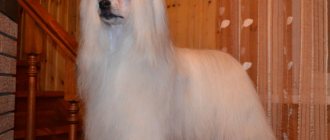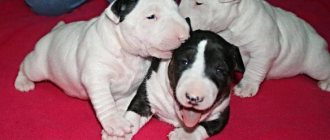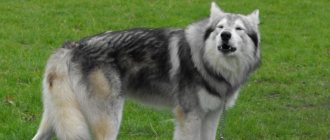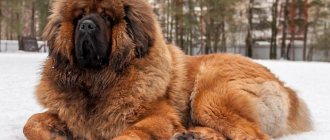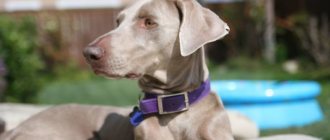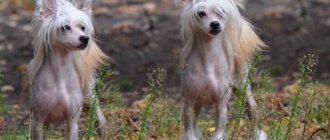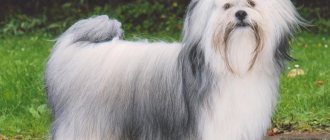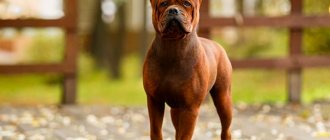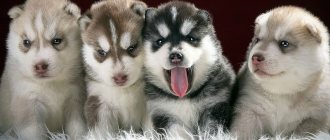When it comes to Chinese dogs, most people think of Pekingese and Chow Chows. Few people even know about the Chongqing breed. It is indeed very rare; the Chinese themselves say that there are even fewer Chongqing pandas than giant pandas. The breed is one of the most ancient. Also known as the Chinese bulldog or oriental hound. Not recognized by the International Canine Federation.
Origin story
About 2000 years ago, when the Han Dynasty ruled the Chinese Empire, a new breed of dog was formed in Sichuan province, which was suitable for guarding and hunting. Strong, dexterous and angry dogs served as irreplaceable helpers for the poor; they could catch not only small animals, but also larger ones. Legends say that Chongqing people were not afraid even of tigers. In those days, peasants kept a dog only if it was useful, could provide food for itself and take care of the owner’s family.
Fate was not always kind to the Chongqing people. Several times the breed was on the verge of extinction and today remains small even in its homeland in China.
The history of the appearance and formation of the breed is shrouded in mystery. Probably due to the fact that until recently it did not arouse interest. Rare mentions in literature and works of art do not allow us to restore the whole picture. The territorial affiliation and use are known, everything else can only be guessed at. Apparently, Chongqing is related to Shar Peis and Chow Chows.
In the late 19th and early 20th centuries in Sichuan and Chongqing provinces, most land was converted into agricultural land. The dogs had nowhere to hunt, which led to a reduction in their numbers. The breed was preserved only due to the fact that some dog breeders continued to keep Chongqing dogs as guards and companions. Since the 1990s, the number of individuals began to increase, and since 2000, the Chinese Kennel Association, together with the National Breed Club and several breeders, began to popularize the breed. Thanks to their titanic efforts, dogs began to spread throughout the world and were exported to Europe and the USA. Currently, the Chongqing is positioned as a multifunctional dog, companion, watchman, security guard and hunting assistant.
Video about the Chongqing (Chinese Bulldog) dog breed:
What to feed?
Due to the natural origin of the breed, its representatives should be fed only natural food. The animal's diet must include turkey, beef, chicken and lamb, as well as heart, liver, kidneys, tripe and other offal. Moreover, the share of meat should be at least 50% of the total volume, and the second half of the diet should consist of buckwheat, rice or pearl barley.
Vegetables should also be on the menu. Moreover, they can be given both raw and baked. The most beneficial for the dog's body are spinach and lettuce leaves, pumpkin, cabbage, beets and zucchini. Twice a week you can give lean fish, pre-cooked and cleaned of large bones, and eggs.
Of course, you can’t offer whole milk, but fermented milk products will come in very handy. The dog will happily eat cottage cheese mixed with raw yolk and hard cheese. The animal can sometimes be pampered with dried pork and beef ears, trachea and chewing bones made from pressed veins. Under no circumstances should you feed your dog peas, beans, potatoes, corn, pickles, smoked meats, as well as bread, sweets and baked goods.
As for the frequency of meals, puppies need to be fed 5-6 times a day. For an adult animal, 2 meals a day will be enough. Bone meal, fish oil, vitamins and minerals should be given as a food supplement.
Appearance
Chongqing creates the impression of a fast, harmoniously built, strong and agile dog, which should not show signs of rudeness. Her silhouette is clear and her body is well balanced. The modern standard, compiled by the Chongqing Dog Breeders Association, distinguishes three height varieties: • Standard - 45-55 cm; size • Medium - 35-45 cm; • Miniature - 30-35 cm.
Regardless of size, the Chongqing is considered as a guard and hunting dog and must have a typical temperament and appearance.
The head is large with a wide muzzle and erect ears. The wings hang down about 1 cm. The muzzle is short with a majestic expression. The outline of the head resembles an inverted trapezoid. The skull is wide, powerful, prominent, tapering towards the muzzle, the occipital protuberance is not pronounced. The planes of the muzzle and skull are almost parallel. The stop is small, but well expressed. The nose is black; Spotted dogs may be spotted, while bronze dogs may be pink or brown. While tracking, the nasal valves make a buzzing sound. The jaws are wide and powerful. The tongue is black or mottled with blue markings. If there are none, the dog is disqualified. The color of the mouth is also close to black. The teeth are very strong, scissor bite. A small undershot of up to 5 mm is allowed. Cheekbones are well developed. The eyes are round or almond-shaped, medium in size, color can vary from black to yellow, depending on the color. The eyelids are well pigmented in black, brown or gray. The ears are small, thin, erect, triangular in shape, covered with short dark hair or without hair. The angle of inclination of the ear axis to the horizon is 50-80°. In this case, both ears should be in the same position. The shape of the auricle resembles a dry leaf.
The neck is powerful and short. The body is almost square in format. The tail is held rigidly upward at an angle of about 70°; to the Chinese it resembles a bamboo shoot. The chest is voluminous with well-arched ribs. The back is short and strong. The lower back is strong. The croup is slightly convex with an inclination to the horizon of about 40°. The belly is tucked in. Limbs with strong bones, strong, slightly dry, straight. The paws are compact and round in shape. The fingers are well closed. The nails are short, thick, dark-colored in dark dogs, and lighter in light-colored dogs. The pads are very durable.
Based on the type of coat, the breed is divided into two more varieties: woolly and hairless. The exterior of dogs is the same, with the exception of hair and teeth (hairless dogs often have incomplete dental formula). The skin on the body forms wrinkles on the head, chest, and withers. They are slightly darker than the main color. The coat is hard, short, and often so sparse that the skin is visible through it. More dense on the neck, limbs and body. The hair adheres tightly to the skin. Color: reddish brown, dark brown, brown, black, white, straw yellow. The most valuable and common colors are red-brown. A small white mark on the chest is allowed.
Description
The Chinese Bulldog is a medium-sized, athletic dog, similar in build to the American Pit Bull. The animal has quite prominent muscles, clearly visible through the elastic skin with short hair. The height of males varies from 35 to 45 cm, females - from 30 to 40 cm.
Such a large difference in growth is due to the presence of 3 types of Chongqing: small, medium and large, which is explained by the formation of its own type of breed in each region. Thus, bulldogs from mountainous areas are noticeably different from lowland ones and, in comparison with them, are stockier and stronger. The weight of males, depending on the type, varies from 14 to 25 kg, females - from 12 to 20 kg.
A characteristic feature of Chinese bulldogs is a straight, thick, medium-sized tail, pointed at the end. It rises high relative to the line of the back and is completely devoid of hair. The head of the Chongqing is somewhat disproportionate in comparison with the body and looks quite large. The upper part of the skull has a flattened shape, which, in combination with clearly defined cheekbones, gives the head a square shape. The bulldog's muzzle is short and wide, which, combined with its square head, looks intimidating.
The Chinese Bulldog's tongue is uniformly black and blue, but pinkish patches are also allowed. The nose is large, black, slightly raised above the muzzle, which is quite typical for hunting dogs. The muzzle is slightly wrinkled, but the number of wrinkles is much less than in Shar-Peis and Pugs. The eyes of the Chongqing are always dark, and the hairless ears are triangular in shape, stand well and are tilted forward.
Separately, it is worth mentioning wool. In most Chinese bulldogs, it is very sparse, which is why the pets look like they are naked, and there is almost no fur on the ears, tail, and sometimes even on the face. Where fur is still present, it is short, rather hard to the touch and colored brown. Black skin is clearly visible through it, which creates the illusion of a black mask on the face, and the animal also has a black tail and ears. The dog's chest is often decorated with a white spot. Recently, the line of appearance of black color has been clearly visible, but experts consider this to be a consequence of crossbreeding - interbreeding.
As for the purpose of the breed, it belongs to the category of hunting and guard dogs, but recently there has been a tendency to keep the Chongqing dog as a companion and even a guide dog. It should be noted that only professionals can raise a dog for these purposes, so if you lack experience and lack confidence in your abilities, it is better to opt for a simpler breed.
READ Balanced menu for the French Bulldog
Character and behavior
Chongqing is a brave, self-confident dog with a strong character, quick-witted and agile, an excellent hunter and guard, has a quick reaction and a strong hunting instinct. The sense of smell is very well developed, which allows it to perform complex search tasks. Chongqing does not bark for no reason, he is self-possessed, balanced and independent. But this does not prevent him from being a devoted friend and companion, and becoming strongly attached to the owner and other family members. Chongqing is infinitely affectionate, friendly and playful with his people.
Chongqing is fearless towards other animals and people, but at the same time not particularly confrontational. Sometimes quarrels can break out between male dogs. In addition, Chongqing is unlikely to be able to live in the society of a fighting dog, whose blood is aggression towards his fellow tribesmen; he will not back down and ignore attacks in his direction. In general, they are friendly enough to live in society.
During puppyhood, special attention should be paid to socialization. We must not forget that the Chongqing is a hunting dog, and therefore may show interest in other small animals, birds, street cats, and sometimes even small dogs.
Owners appreciate amazing insight in their Chongqings. These dogs are able to adapt to the mood and character of the owner, they are sociable and ready to make compromises. If Chongqing is familiar with children from puppyhood, he treats them with tolerance and care as adults. Of course, communication between a dog and a child should always remain under control.
Chongqing has a high degree of distrust of strangers. But, if the dog is well trained, the risk that it will attack without a command or serious reason is minimal.
Education and training
Chongqing has strong leadership abilities. He is independent and quite smart, but is not inclined to unquestioning obedience. Training should be done by an emotionally strong, strong-willed person with a balanced character. It’s good if he already has experience in keeping similar breeds, independent and independent. Methods developed for service dogs are not suitable for training and education. What is more important here is the close contact between the dog and the person, as well as the owner’s ability to take and maintain a leadership position. Chongqing as a puppy will be trained for a treat or toy, but an adult dog will comply with requests out of respect for the owner.
Chongqing's strength of character and independence sometimes surprises even professional dog handlers. It will be difficult to take control of such a dog and raise it correctly.
At the age of 7-10 months, when puberty begins, males and, to a lesser extent, days can try to take a leading position, even with aggression. In this case, it is important not to miss the moment and show the dog your primacy in time. This does not necessarily have to be the use of physical force. First of all, persistence and the requirement to follow the rules established by a person are important. During this period, it is very important not to be led by the dog and not to give it the opportunity to independently determine the place or duration of the walk, the time or place for sleep and other everyday trifles.
Chongqing is not the best choice for beginners. The dog will be suitable for an intelligent, experienced, strong-willed owner who will be able to correct his behavior in a timely manner.
Beauty is in the genes
Looking at the photo you understand that this dog is very noble and proud. Moreover, regardless of whether this is a photo of the animal “standing” or while relaxing on the grass. No matter what photo you take of the animal, it always looks majestic and full of dignity.
It is difficult to buy a representative of this breed. Firstly, the breed is poorly represented on the European market. Secondly, the price of a puppy is quite high. At the same time, it is strongly not recommended for a novice dog breeder to purchase a puppy (even if the price suits you). After all, only a person with experience can cope with this strong-willed and independent animal.
If raising an animal requires a special approach, then caring for it is quite simple.
Content Features
In the middle climate zone, Chongqing is not suitable for outdoor living. This is due to the very short and sparse coat, which does not keep you warm in the cold season. Chongqing is suitable for home or apartment living. The dog will not be embarrassed even by the small dimensions of the living space, provided it is given good walking.
Chongqing is very energetic and active, so it is very advisable to find him something to do. These can be strength sports, for example, weight-pulling or running, including running behind a bicycle. As for obedience competitions (obedience, agility and other similar ones), Chongqing dogs rarely show good results in them. Aviary or chain keeping is not recommended. In addition, Chinese Bulldogs are not suitable as apartment dogs for people who do not have the ability to provide sufficient physical and mental exercise.
The lack of good walking, work and regular training will certainly entail consequences: disobedience, destructive behavior, outbursts of aggression.
Care
Caring for Chongqing is easy. It is enough to brush the dog regularly with a special rubber mitten or a brush for short-haired breeds. Then the molting goes completely unnoticed. The frequency of washing is individual. It is very important to choose the right shampoo that will not dry out the dog’s delicate skin, which is already prone to dermatological diseases. Ears, teeth, claws and eyes also need care. The ears are cleaned as necessary from accumulated excess wax. The eyes are wiped, removing secretions from the corners; it is important that they are always clean and dry. The claws normally grind down on their own, but if for some reason this does not happen, they need to be trimmed as they grow back. Chongqing teeth are prone to tartar formation and early loss, so owners should take dental disease prevention seriously. From early childhood, teach your dog to regularly brush its teeth and perform the procedure at least twice a week. If tartar appears, it should be removed promptly by a veterinarian.
Nutrition
Chongqing adapts well to different types of food: natural, mixed or prepared food. But it is worth considering that sometimes they suffer from allergies to certain foods or a weak digestive system. In this case, it will take a long time to select suitable products or food of a certain brand. In addition, they note a tendency to gain excess weight, especially in the absence of proper physical activity. For Chongqing, diet and correct calorie portion calculations are important. The diet must correspond to the dog’s physical activity, age and physiological condition.
If the dog eats natural food, be sure to give courses of vitamin and mineral supplements. When feeding exclusively with ready-made food above the super-premium class, no additional supplements are required for preventive purposes.
Proper care
The Chinese Bulldog is quite active. He needs a walk twice a day, and during the walk this dog needs to run. Lack of physical activity will make the dog think about where to apply force. As is the case with many other active breeds, the result can be damage to the property of a beloved owner.
Caring for the handsome Chongqing is simple. His shiny coat, which nature has endowed him with, does not require combing or any other procedures. The dog should not be bathed frequently, and if such a procedure is necessary, you need to choose the right shampoo. Do not neglect the advice of specialists, ask for the opinion of a veterinarian and under no circumstances use household chemicals or cosmetics intended for humans to care for your pet.
Health and life expectancy
As a rule, Chongqing has good health and good immunity. However, it is not uncommon for the breed to give birth to puppies with various mutations: lack of hair, malocclusion, incomplete dental formula, a tendency to dental diseases, etc. Various skin and eye diseases are often reported. Dogs that do not suffer from bad heredity are often long-lived and 15 years is not the limit for them.
To maintain health, it is important to provide Chongqing residents with a nutritious balanced diet, timely vaccinations and treatment against external and internal parasites.
Choosing a Chongqing puppy
There are only about 1,000 Chongqing dogs worldwide. The main livestock is concentrated in China. A certain number live in the states, Western Europe and the CIS countries. The easiest way to buy a puppy in China is through the Chinese Chongqing Dog Club. The same organization is engaged in the preparation of documents for puppies and adult dogs, including export ones, as well as registration of breeders and other issues.
Finding a kennel that breeds Chongqing dogs is not difficult; it is much more difficult to find a free puppy for sale. There is usually a long queue for children. Puppies are very different from adult dogs, they have many more folds, which smooth out with age, and very sparse hair, it seems that the whole body is covered with bald spots. Dogs become fully grown closer to a year. It is important to pay attention to the condition of the skin, teeth, eyes and ears. Outwardly, babies should be healthy. Temperament also matters. They should not show aggression or cowardice. Curiosity, playfulness and friendliness: the most obvious traits before the age of 2-3 months. They also pay attention to compliance with the Standard, the balance of the body, the strength of the paws, the setting of the ears, the color of the mucous membranes and the color of the coat.
Price
A Chongqing puppy is not cheap. In Russia, the average price is 70,000 rubles. Kennels in China sell exclusive rare dogs for 15,000-25,000 kWh. yuan, which is approximately equal to 2,500-4,000 dollars.
